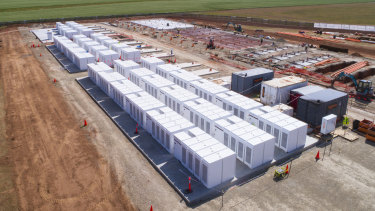Regulator sues Tesla Big Battery in Federal Court over power grid promises
Australia’s Tesla Big Battery, one of the world’s biggest lithium-ion batteries, is facing legal action amid allegations it failed to deliver on its promise of providing services essential to maintaining the stability of the power grid.
The Australian Energy Regulator has filed Federal Court proceedings against the Tesla Big Battery, known as the Hornsdale Power Reserve, which is owned and operated by French renewable energy giant Neoen.

It is alleged the Hornsdale Power Reserve failed to provide “frequency control ancillary services” – services used by the energy market operator to maintain the safe frequency of the grid following power disruptions – despite making offers and receiving payment from the market operator to be on stand-by to provide them.
Tech billionaire Elon Musk’s Tesla built the huge battery in a remote area of South Australia in 2017. Paired with the adjacent Hornsdale wind farm, the 150-megawatt battery with 193 megawatt-hours of storage has helped reduce intermittency and manage increased demand during periods when the grid is under the most strain.
The Australian Energy Market Operator (AEMO) informed the regulator of Hornsdale’s alleged conduct after a power system disruption at Queensland’s Kogan Creek power station in October 2019.
Hornsdale’s failure to provide the services as promised “undermined AEMO’s ability to maintain frequency” and put the power system’s security and stability at risk.
“It is vital that generators do what they say they can do if we’re going to keep the lights on through the market’s transition to variable renewable generation,” Australian Energy Regulator chair Clare Savage said.
“AEMO relies on accurate information and compliance with offers and dispatch instructions to ensure it can effectively stabilise frequency deviations.“
The regulator said it was seeking penalties, declarations and costs.
Neoen Australia managing director Louis de Sambucy said Hornsdale had repeatedly delivered on the high expectations of its performance and market impact since beginning operations in 2017, “proving itself to be a critical component of the South Australian electricity network”.
“Whilst we are disappointed by the AER decision, we will continue to maintain our collaborative relationship with them,” he said.
In its first two years of operation, the construction of the Tesla Big Battery has saved consumers more than $150 million, according to Neoen.
A report by Aurecon in 2019 found the big battery had reduced the cost of frequency ancillary services in the National Electricirt Market by about $116 million in 2019.
Tesla’s Hornsdale project kickstarted a wave of Australian big batteries – technology considered key to supporting the greater uptake of renewables by overcoming the problem of intermittency when it is not sunny or windy.
Big batteries capture and store excess power generated during times when conditions for renewable energy are most favourable, and then release it when it’s needed during peak-usage periods such as during heatwaves.
The Business Briefing newsletter delivers major stories, exclusive coverage and expert opinion. Sign up to get it every weekday morning.
Most Viewed in Business
Source: Thanks smh.com